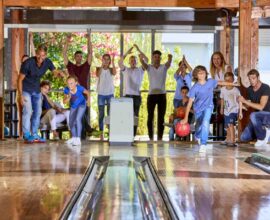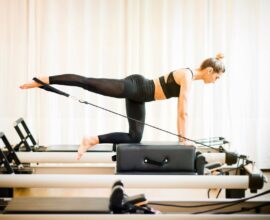Climbing and children: all the benefits and tips for beginners
Climbing is a complete, safe and satisfying sporting activity to practice since childhood
Adventure, fun and sociability, but also more balance and flexibility as well as greater coordination and problem-solving ability: climbing can bring numerous benefits like these for the psycho-motor development of children.
Pediatricians and experts of development age agree that physical activity, when practiced from childhood, can contribute significantly to the physical and cognitive development of children, as well as enhancing their social and behavioral skills and improving very important skills such as problem-solving and lateral thinking.
Of course, the benefits of sports that can vary according to the different disciplines and their nature. For example, dynamic team sports such as football and basketball help to instill team spirit in children and improve breathing capacity and physical coordination, while other practices based on endurance, such as road cycling and mountain biking, allow to gain more self-confidence, refine the sense of balance and strengthen lower limbs.
Anyway, despite these differences the basic message is that children can benefit greatly from the wide variety of stimuli offered by sporting activity, even when it just comes to putting themselves to the test and exploring a different context than school and home, far from the constant attraction coming from electronic devices or homework and tasks to achieve, and learn the value of consistency dealing with recurring commitments on a weekly basis.
Often, many parents find it difficult to choose the sporting discipline that best suits their children inclinations. Is it better a group or individual sport? An outdoor or indoor sport? A racket sport maybe? As a matter of fact, not all sporting disciplines are the same, and children do not always show particular talents or aptitude towards one sport or the other.
It is therefore not a simple nor obvious choice, especially if a child doesn’t show particular talents or interest, or lose enthusiasm the other way round. A good solution for situations like that could be climbing, a complete and fun sport truly suitable for everyone, capable of stimulating children to move following natural instinct, which brings numerous effects and benefits concerning the harmonious growth in both psycho-physical and cognitive spheres.
Climbing and children, a win-win combination
Speaking of climbing, we are often led to imagine an extreme and dangerous sport, reserved for a few brave experts, certainly not a sporting activity designed for children. The reality is different, as there are several forms of climbing that are more “quiet” than classic mountain rock climbing and suitable for children too, such as indoor climbing over artificial walls equipped with special holds on different positions and shapes determining the overall difficulty degree of the wall.
Thus, under the guidance of expert instructors, children can learn the basics of the discipline while enjoying a safe and controlled environment, which allows them to develop their motor abilities and cognitive skills and build more self-confidence. Climbing is perfect to teach children how to overcome difficulties, even those that seem impossible to face, and achieve relevant goals; it also enhances their self-esteem, a key factor which then will inevitably spill over into other areas of life.
Not to mention that climbing is one of the motor activities that children basically already know by nature since day one and, unlike other sporting activities which require learning more complex movements and techniques (such as volleyball or even more tennis), it involves an intuitive natural movement pattern that can therefore be learned rather immediately, stimulating the key brain areas controlling psycho-motor actions.
Multiple studies and practical applications, indeed, have long demonstrated the potential of climbing helping children suffering from childhood neuro-physical disabilities to recover their capacities, especially if included in a well-designed rehabilitation plan and practiced on special sensorized walls.
It is certainly no coincidence that, over the last few years, were established more and more gyms and sports centers providing climbing courses, designed for children as well, including the best walls and equipment to practice this sport; the best way of responding not only to their innate need for freedom and fun, but also to parents wishing to see their children involved in effective activities for growth and continuous learning.
Physical and cognitive benefits of sport climbing for children
Introducing children to climbing from an early age (experts suggest starting around 5 years old) can be an excellent choice to foster their growth in a healthy and conscious way, contributing to the harmonious development of mental skills, physical skills, and individual soft skills which turn useful in everyday life, including the ability to relate proactively with peers and instructors or to make decisions quickly and effectively.
And that’s not all, as there are much more benefits that children could get practicing a sport like climbing. Let’s check them out:
- More strength and endurance: climbing involves muscles all over the body, including arms, legs, back and torso, thus it enables children to develop their movement muscles by using strength to lift their own body weight step by step;
- Greater flexibility: to achieve specific positions and movements while climbing, children must develop very good flexibility and joint mobility, which are fundamental for preventing injuries, such as muscle pain or joint problems, as they become more and more frequent as the years go by;
- Better coordination and balance: climbing requires good coordination and a proper sense of balance, as children have to learn to move fluidly over the walls and in a controlled way, strategically planning each step and deciding how to advance and where to place their fingers or feet, key skills that can then be useful practicing any other sport;
- Increased cardiovascular endurance: although climbing is generally considered an anaerobic activity, so with high intensity but short duration, it can still offer considerable benefits for cardiovascular health as the repetition of climbs and demanding movements can help to improve the endurance of heart and lungs, essential for sustaining even prolonged efforts;
- Stimulation of the nervous system: climbing involves to perform a series of complex movements that activate the central nervous system, improving the mind-body connection and increasing body awareness and muscles coordination;
- Increased self-esteem and self-confidence: overcoming obstacles and reaching new heights on the wall has a positive impact to increase children’s self-esteem and confidence in their own abilities, providing a sense of achievement and gratification that can improve performances also in other areas of life, including study and social relationships;
- Reduction of anxiety and stress: the high levels of attention required during climbing force children to focus on what’s happening in that exact moment, reducing stress and anxiety related to school, family, or friends, moreover a sporting activity like this can be excellent to face and defeat fears, and therefore to learn new ways of managing and overcoming them;
- Development of cognitive abilities and problem solving skills: climbing requires to develop a good ability in analyzing new situations, planning moves in advance and solving problems in real time, three crucial aspects for children’s cognitive development, in particular to enhance working memory and problem-solving skills;
- Promotion of creativity: climbing requires a good dose of creativity, especially when it comes to formulating alternative solutions to get around obstacles on the wall and reach the top, an extremely important way to develop relevant and all-life long useful soft skills such as lateral thinking, the ability to think “outside the box” and solve multiple problems;
- Sense of accomplishment and personal pride: when children achieve goals or overcome a climbing challenge, they experience a sense of personal accomplishment and pride that can positively influence their overall self-esteem and motivation;
- Promotion of sociability: although it cannot be specifically defined as a team sport, climbing requires children to interact and cooperate together with other climbers and develop valuable social skills such as communication and teamwork.
Five tips to practice climbing safely and with satisfaction
Climbing gives children the opportunity to challenge themselves and their fears, developing physical and mental skills that will certainly be useful all over their lives. However, before joining this exciting adventure, it is essential to ensure that children begin climbing practice safely and with the right knowledge and precautions.
Here are some key tips for a safe and rewarding practice, concerning the adequate training on the correct use of the equipment, the constant supervision and the compliance with safety rules, which will allow both parents and children to approach the magical world of climbing in tranquility.
1. Equip yourself with the necessary equipment
To practice climbing safely it’s needed adequate and good quality basic equipment, including a helmet, harness, carabiners and ropes. In particular, it is essential that all equipment fits the age and weight of the child. Anyway, before purchasing or renting equipment, it is advisable to inform yourself with the review of an expert; moreover, it’s important to regularly check the condition of equipment to spot potential signs of wear.
2. Make sure you have good physical and mental preparation
Before starting climbing, children must be adequately prepared both physically and mentally. So, before each climbing session, it is a good idea to teach them some simple warm-up and stretching exercises for muscles that will mostly be stressed on that climbing, in order to prevent any injuries and face the wall with determination. At the same time, climbing is an activity that requires a high level of concentration and self-confidence, which is why it is important to explain children that first of all the wall is safe, and secondly that they are capable of climbing it, simple powerful beliefs that will be gradually further strengthened as young climbers get greater mastery with the practice.
3. The importance of constant supervision with a good instructor
It is important that children are always under the supervision of an experienced adult while practicing climbing, a good instructor able to provide real time assistance and support if necessary, and of course take action in emergency situations. The instructor can also indicate the most suitable walls according to children’s experience and skill level, constantly checking their progress to allow them to gradually increase the difficulty as the improvements become more and more evident. As a matter of fact, there is nothing more harmful and demotivating than failing in the achievement of a specific climbing task and realizing the inability to face the challenge, a scenario that could lead to the abandon of this sporting activity.
4. Compliance with the rules concerning behavior and safe falls
It is very important to teach children the rules for good behavior in the climbing gym and how to effectively respect them. This includes the knowledge about the correct use of equipment, the respect for other climbers and active cooperation with gym staff. Furthermore, instructors have to introduce children to the proper technique necessary to for a safe fall, as potential mistakes could happen and make it necessary to control both fall and landing with the correct position of feet, arms and head.
5. Choice of gym and climbing wall
The last key point to consider refers to the choice of gym or climbing wall (usually indoor walls are easier for beginners). More specifically, it is a good idea to choose a place that is safe and suitable for children, which provides walls of adequate height and level of difficulty. Some sports academies, such as the Forte Village Climbing Academy, offer climbing courses specifically designed for children to introduce them to the basic techniques of the discipline in a controlled and safe environment.
The climbing school at Forte Village Resort
Enjoying the relaxed and playful atmosphere of a five-star luxury resort nestled in many acres of lush Mediterranean scrub, and then diving into the calm waters of some of the most beautiful beaches of Southern Sardinia: this would be the dream of every child, but especially the wish of every parent, who could make sure that their children learn the basic of climbing with the help of expert teachers while they relax with the fantastic treatments at the Acquaforte Thalasso & Spa.
All this turns into reality at the Forte Village Resort, a luxury location located next to Santa Margherita di Pula, an enchanting seaside resort in Southern Sardinia which has always been known for its rich offer of excellent sports facilities and academies, including the much-loved Tennis Academy and Fencing Academy; and last but not least, the very well-equipped Climbing Academy.
During all sunny and holiday season, from the end of May until the beginning of September, children will have the opportunity to test themselves with an exciting and fun sport, under the careful supervision of qualified instructors who will teach them to master the climbing techniques suitable for their age and level of physical and mental preparation, in full compliance with safety regulations.
Moreover, upon registration, all children will receive the magnificent Climbing Academy Kit, the essentials to join this exciting adventure!
For further information or for booking the next lesson at the Academy, please phone call to the number +39 070 9218818 or write an email to holiday@fortevillage.com.
Do you want to discover the benefits of climbing with your children and experience a fairytale holiday in an authentic paradise? Discover the Forte Village Resort in Sardinia






